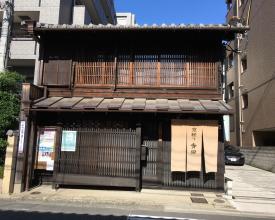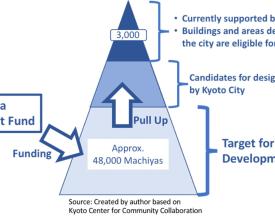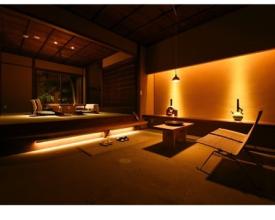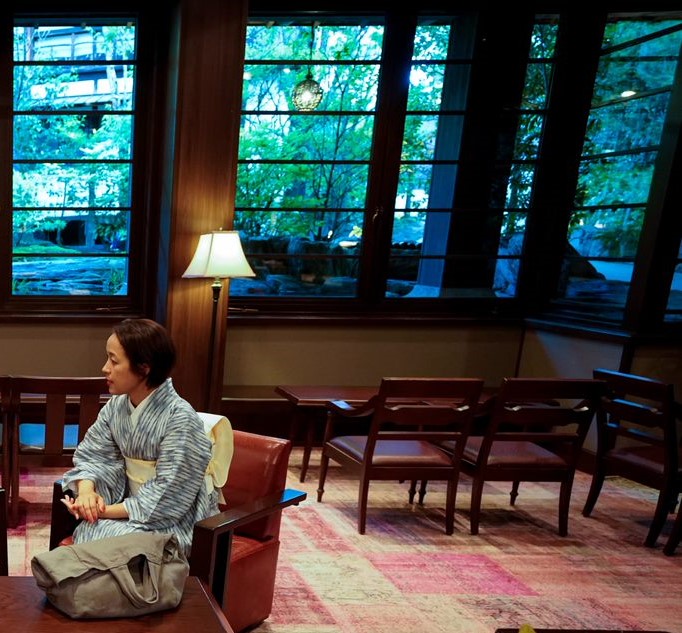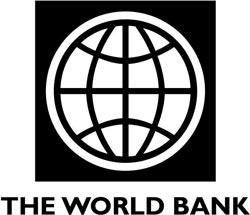
Innovative Financing Mechanism for Preserving Traditional Housing (Machiya)
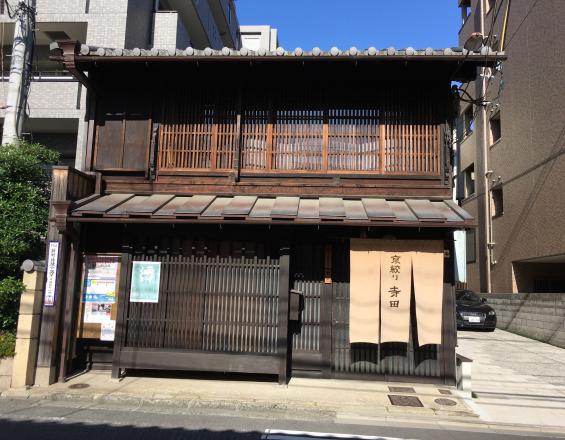
Machiya is a general term referring to traditional low-rise workplace-cum-dwelling townhouses. The traditional towns in Kyoto would have many machiya packed tightly and neatly along the streets, thus creating a dense and lively community. To preserve this traditional culture and pass it on to the next generation, Kyoto City and its partners have recently set up several initiatives utilizing innovative financing mechanisms. Their schemes included donations from stakeholders, micro-credits for restoring the machiya, soft loans, and others. This Solution shows how the various financing schemes are helping in preserving the traditional houses.
Contexto
Défis à relever
Machiya are disappearing, and so is the truly traditional townscapes of Kyoto. The total number of machiya in Kyoto is approximately 40,000, but every year, the city loses 700-800. Kyo-machiya, are known for their lavish use of relatively elaborate and delicate materials and their light, supple construction. The building technique of placing columns on cornerstones is an ancient one commonly used for shrines and temples. As machiya are disappearing, the craftsmanship is also on the verge of extinction. Given the significance of Kyo-machiya, creative financing schemes have been adopted by Kyoto city to preserve their heritage houses.
Ubicación
Procesar
Summary of the process
Kyoto case has become a role model, which is being emulated by the machiya all over Japan. Atypical financing mechanisms are inspiring the heritage conservation in other cities of the world. The building blocks presents the financial schemes for preserving machiya, including donations from stakeholders, micro-credits for restoring the machiya, soft loans, and matching programs. This challenge also brought those schemes to the knowledge of owners, citizens, and other stakeholders. Importantly, as Kyo-machiya are unique structures built with unusual architectural skills, preserving the craftsmanship while renovating a Kyo-machiya have also helped in overcoming the challenges successfully.
Building Blocks
Kyo-machiya Development Fund
Together with the Kyoto Center for Community Collaboration, Kyoto City established the Kyo-machiya Development Fund in 2005. This fund aims to promote the preservation, restoration, and utilization of machiya based on donations from residents, companies, and external supporters in addition to financing by both the national and local government. Another important aspect of this fund is that it is complementary to Kyoto City’s efforts to preserve machiya and the historic urban landscape. The number of machiya the local government can support is limited due to budget constraints. Currently, around 3,000 machiya are supported by Kyoto City. As illustrated in a gallery photo, the Machiya Development Fund provides support to machiya at the bottom of the pyramid and attempts to pull them up to a higher category, which is then considered for public support by the city. The Machiya Development Fund began with 150 million JPY in 2005. By March 2016, the Machiya Development Fund supported a total of 76 renovations and restorations of Kyo-machiya. The number of inquiries is recently increasing, and currently it is around 500 every year.
Enabling factors
- An initiative by the city and its partners to establish an innovative development fund to preserve, restore, and utilize machiya and the craftsmanship.
Lesson learned
At the end of the day, fate of the projects is decided by the funds. This is truer for heritage conservation projects, which may not always find priority position in the list of infrastructure projects to be implemented. As governments' budget is limited, many owners of culturally important buildings and houses look for alternative funding sources to preserve their inheritance; otherwise they would demolish the structures and sell off the land. Innovation in financing has encouraged the machiya owners to retain the structures and not convert to other businesses or condominiums. This in turn has helped in keeping the heritage of Kyoto downtown intact and impacted the tourism of the city positively.
Supporting Kyo-machiya Crowdfunding
In 2016, Kyoto City and the Kyoto Center for Community Collaboration launched a crowdfunding program for machiya aiming to tap into a wider range of funding sources. Eligible projects are renovations and utilization proposals of machiya, and since machiya are often used as lodgings or restaurants, projects in this program are mostly interior renovations for hotels and restaurants. Initially, the program provides a maximum of 1 million JPY to cover costs for preparing a crowdfunding proposal. Once the proposal has gathered more than half of the target amount of money, the program fills in the financial gap by maximum 3 million JPY. In fiscal year 2017, Kyoto City announced that the program will accept up to four project proposals. As of March 2018, there is one ongoing project that proposes to renovate a machiya into a traditional-style hotel and to create an open factory next door where visitors can experience the making of traditional goods.
Enabling factors
- Collaboration of Kyoto City and the Kyoto Center for Community Collaboration to set up the supporting program for machiya crowdfunding.
- City’s financial assistants to prepare crowdfunding proposals and fill in the financial gaps.
- Utilizing an existing crowdfunding platform for renovation and utilization of machiya.
Lesson learned
The increase in the number of funding options for renovation has increased the momentum in the restoration and use of Kyo-machiya. Innovative mechanisms involving private funds has decreased the dependence on national and municipal taxes, giving Kyo-machiya an independent identity and perhaps longer sustainability.
Special Loan Products for Machiya Conservation
Since 2010, public interest in machiya conservation has surged and banks have begun offering tailored restoration loans for these bygone architectural artifacts. Recently, the Kyoto Center for Community Collaboration created and issued “Machiya Karte”s, imitating the clinical records used in medical care. By documenting the uniqueness and value of each machiya building in a tangible form, the liquidity of machiya as a tradable good increased significantly. As a result, as of March 2018, three local banks have started special loan products for machiya renovation or utilization. For example, Kyoto Credit Bank provides both consumer (accommodation) loans and corporate loans. The former offers 1-100 million JPY at the interest rate of 1.8-2.0%, as opposed to the normal housing loan requiring 2.675%. The latter offers 30 or 50 million JPY at the interest rate of 1.2-2.3%, depending on the period and whether collateral is provided. From 2011 to 2017, the consumer loan product won 123 contracts, and the corporate loan product won 7 contracts.
Enabling factors
- The Machiya-Karte project documented the uniqueness and value of each machiya building in a tangible form
Lesson learned
These loans are made possible by a public-private cooperative agency that certifies structures as legitimate machiya, provides banks with estimates of the necessary restoration work, and subsidizes each restoration project. These loan products, combined with other initiatives by Kyoto City and its partners, are expected to further boost the preservation, restoration, and utilization of machiya.
Machiya Heritage Network and the Machiya Matching Project
27 organizations including experts on machiya preservation, NPOs, NGOs, and Kyoto City gathered to form the Machiya Heritage Network. Their flagship initiative is a matching project called “Match-Ya”. Match-Ya is a platform connecting machiya owners and potential residents or business owners interested in the utilization of machiya. From the supply side, the current situation is that many machiya are already unused and empty, but their owners are not sure what they can do with their machiya and whose advice to seek. From the demand side, many business owners are interested in utilizing machiya for new businesses, often combining traditional values and modern industries. By reaching out to Match-Ya, both owners and potential buyers or tenants can access consultation services and support from the Machiya Heritage Network members in areas such as real estate, law, financing, building regulations, public subsidies, etc. They can further collaborate with designers to create business plans, advertisements, and public relation strategies. If the requirements of the owners and the aspirations of the tenant matches, then the machiya can be utilized for a new purpose. To date, several successful matchings have already been made.
Enabling factors
-
Collaboration of the city and various organizations to form a network with the aim of machiya preservation
-
Establishing a platform where both machiya owners and potential buyers or tenants can access consultation services and support from assorted experts to utilize machiya
Lesson learned
Preservation of Kyo-machiya is a perfect example of coordinated efforts by the local governments, residents, companies, businesses, and private players for cultural development. Process of restoring Kyo-machiya is a participatory and consultative process, and the stakeholders have been forthcoming in contributing resources and taking ownership of the outcomes. It is noteworthy to understand that mobilizing stakeholders in this manner is critical to the success of the projects, especially those that demand high funding. This is achieved by making them equal partners and giving them autonomy in decision making, while supporting them with legal and financial aspects.
Preserving Craftsmanship
Kyo-machiya are unique structures, built with an unusual architectural skills and craftsmanship. For keeping the craftsmanship intact, while renovating a Kyo-machiya, various people and organizations pool in their knowledge, including citizen’s groups who take the perspective of the property owner, local financial institutions, and real estate agents.
Community Collaboration University, under the aegis of Kyoto Center for Community Collaboration organized Kyo-machiya Revival Seminars. They provide opportunities to learn more about Kyo-machiya, such as - how it constructed, where the traditionally used materials are sourced from, how to manage and maintain it, how to inherit and rent it, and how to make it a better place to live in. These seminars give opportunity to learn about Kyo-machiya as an architectural form familiar to residents and how it can be revived.
Enabling factors
-
Revival seminars that provide opportunities to learn more about Kyo-machiya as an architectural form familiar to residents and how it can be revived.
Lesson learned
While such efforts have been arduous, special training from architects and craftsmen well versed in traditional Japanese structural design and carpentry, have helped in overcoming the challenges successfully. The trainings have created a platform for the future generations to learn from the machiya architecture and apply some traditional techniques to contemporary work.
Impacts
Economic Impact: Application of innovative financial schemes to preserve Kyo-machiya has not only significantly decreased the demolitions of machiya since 2010, saving Kyoto’s culturally irreplaceable cityscape from imminent destruction, but the restoration endeavor has provided the ancient city with new financially rewarding prospects. Hundreds of machiya have been turned into shops and restaurants or converted to quaint rental accommodations, attracting more tourism. With the number of visitors to Japan estimated to rise above ten million people, the residents of Kyoto are likely to benefit from the machiya restoration efforts.
Social Impact: A fusion of old and new Japan, Kyoto’s machiya are testaments to the revered architectural heritage of Japan as well as the capacity for any given culture to protect the monuments of its historical past and retain its sociocultural roots. Preservation of Kyo-machiya has been successful with mobilizing finances from many stakeholders, including the residents and governments. The restoration has become a case study for many countries aiming to conserve their cultural heritage on how to generate and manage funds, create awareness, and engage people in historical conservation.
Beneficiaries
- Residents of Kyoto City
- Private companies in Kyoto City
